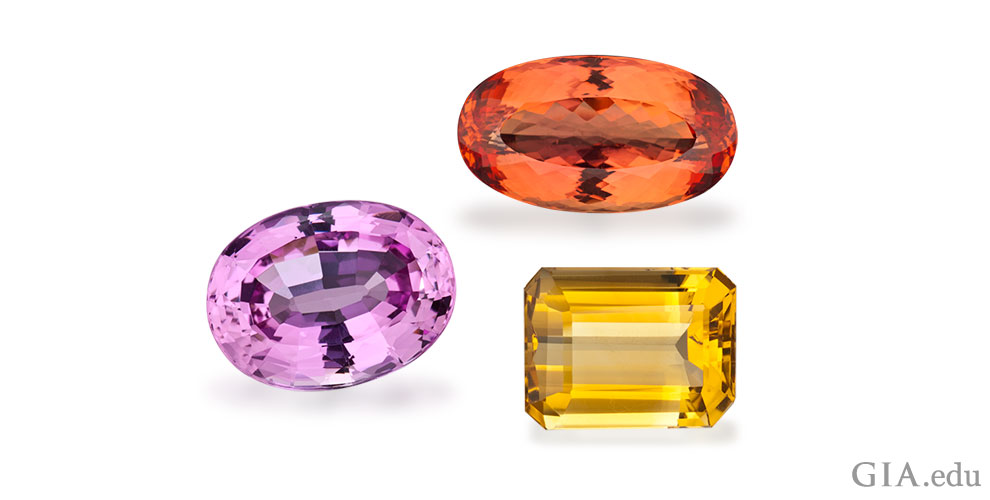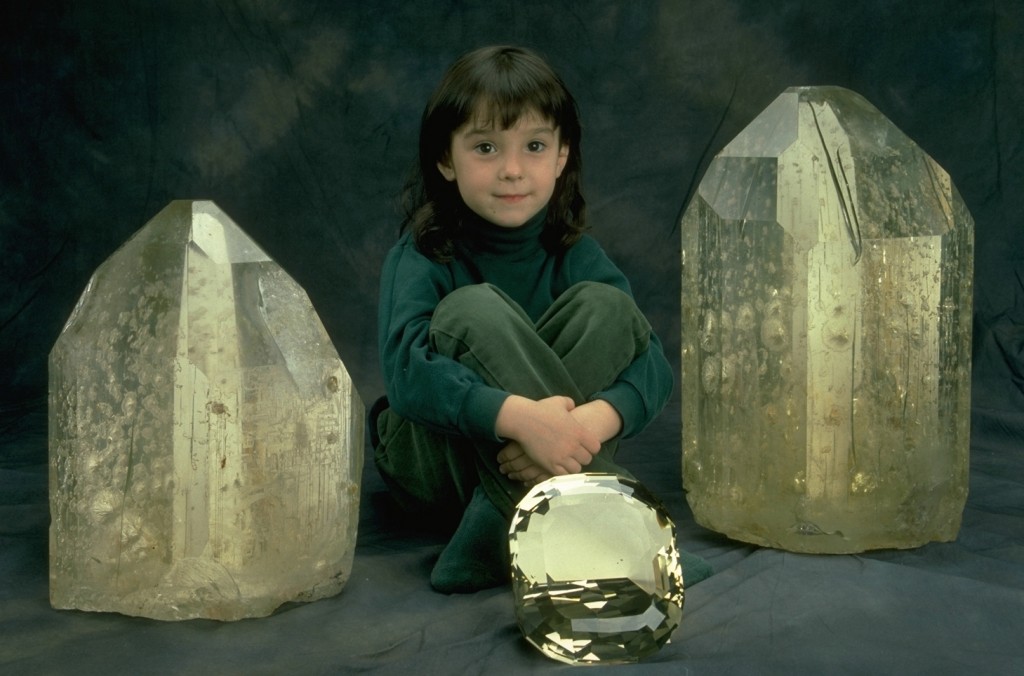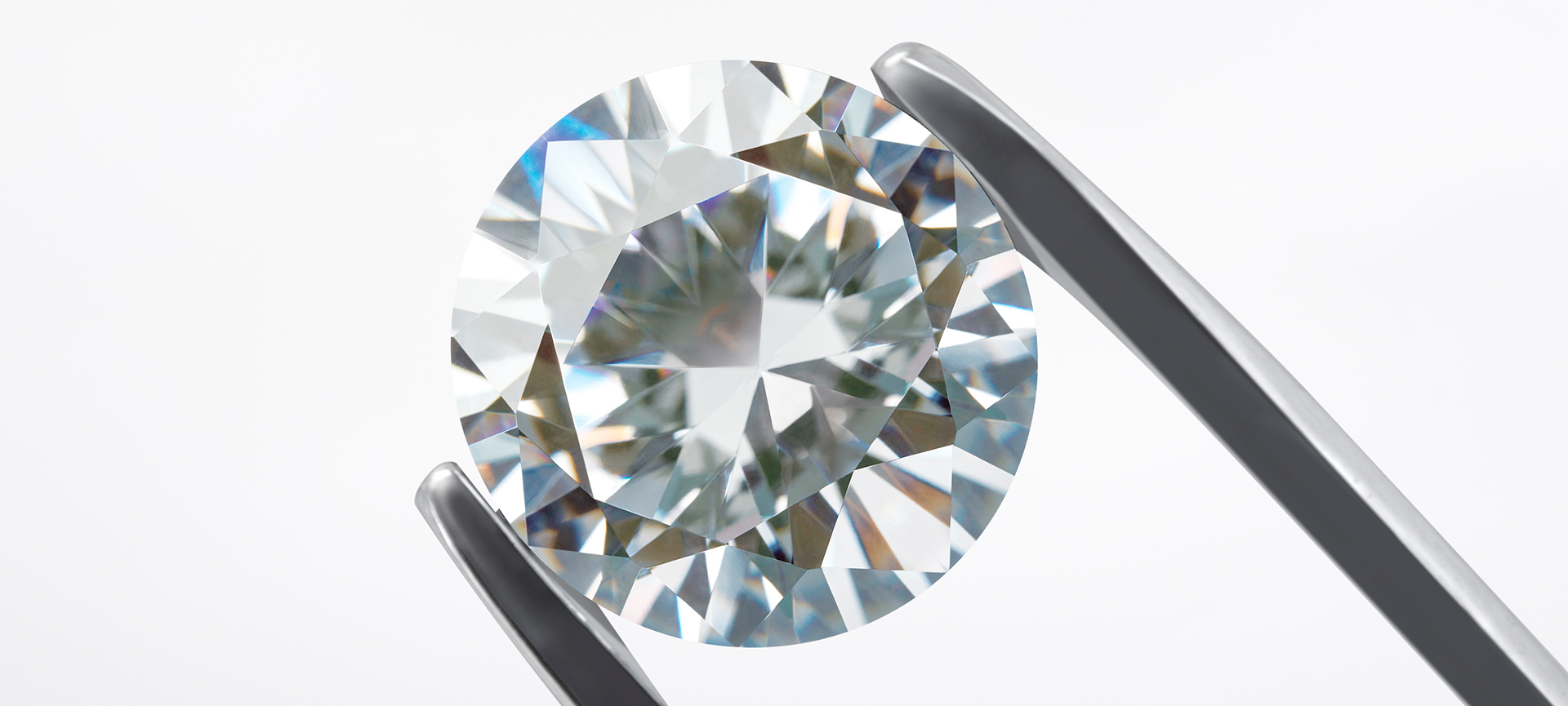Those with a November birthstone have two beautiful options to choose from: topaz and citrine. Topaz comes in a rainbow of colors; citrine is known for its charming yellow and orange hues. The two gems give you countless options. Your challenge will be deciding which one to pick. We offer help.
In this post, we cover
Gemological properties of topaz
Topaz history & lore
Where topaz comes from
Qualities to look for in topaz
Topaz treatments, care & cleaning
Gemological properties of citrine
Citrine history & lore
Where citrine comes from
Qualities to look for in citrine
Citrine treatments, care & cleaning
November birthstone: Gemological properties of topaz
The November birthstone topaz has an exceptionally wide color range that, in addition to brown, includes various tones and saturations of blue, green, yellow, orange, red, pink and purple. Colorless topaz is plentiful, and is often treated to give it a blue color.
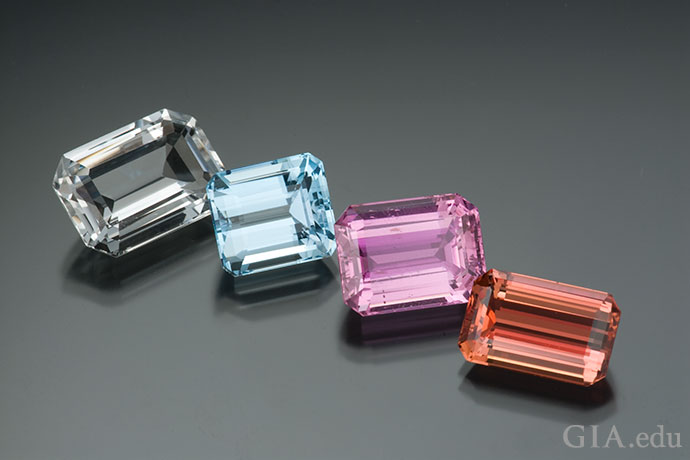
Pictured here are some of the many colors of topaz. From left to right: a 9.21 carat (ct) colorless emerald cut from Nigeria; a 15.01 ct light blue emerald cut from Brazil; an 18.41 ct purplish pink emerald cut from Pakistan; and a 12.54 ct orange-red emerald cut from Brazil. Photo: Robert Weldon/GIA
Color varieties of the November birthstone are often identified simply by hue name—blue topaz, pink topaz and so forth—but there are also a couple of special trade names. Imperial topaz is typically a medium reddish orange to orange-red though some dealers, especially those in Brazil, apply the term to yellow, pink and red topaz as well. The reddish pleochroic color (pleochroism is the display of different body colors from different viewing directions) of Imperial topaz often appears at the ends of fashioned gems–like pears and ovals–that have an otherwise yellow-to-orange body color. Red is one of the most sought-after (and least available) topaz colors.
Sherry topaz—named after sherry wine—is a yellowish brown or brownish yellow to orange. Stones in this color range are often called precious topaz to help distinguish them from the similarly colored but less expensive citrine and smoky quartz.
Topaz is an 8 on the Mohs Scale of Hardness. It’s not very tough, so a hard blow might split it, and extreme pressure or sharp temperature changes might cause it to break. The November birthstone is best set in a protective mounting like a bezel or used in pieces that aren’t subjected to heavy wear, like pendants and pins.
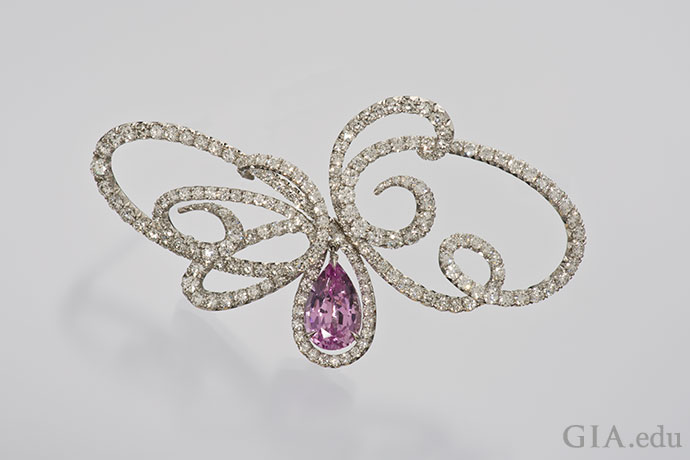
A pink topaz set in a diamond and platinum butterfly brooch is a delightful sight. Photo: Robert Weldon/GIA. Courtesy: Richard Krementz Gemstones
Gemologists love topaz because it comes in some of the gem world’s largest crystals: The largest are measured in kilos, not carats. They also love the fact that faceted topaz takes such a high polish and is slightly slippery to the touch.
November birthstone: Topaz history & lore
Topaz was long thought to have many benefits. The ancient Greeks believed that topaz gave them strength. From the 1300s to the 1600s, Europeans thought it could thwart magic spells and dispel anger. The November birthstone was also believed to have curative powers. To treat “dimness of vision,” 12th century abbess St. Hildegard recommended placing topaz in wine for three days and then rubbing the moistened topaz on the patient’s eyes.
Imperial topaz has aristocratic cachet. It is commonly believed that the name originated with the Russian royal family’s insistence on keeping the finest colors of this gem, which was mined in Russia’s Ural Mountains, exclusively for their use. An alternate explanation, especially popular in Brazil, is that it dates from an 1881 visit by Brazilian Emperor Pedro II to Ouro Preto—the town closest to Brazil’s most productive topaz mines–and the gift of a reddish topaz to him. Regardless of the source of the designation, there is no question all believed this beautiful gem was fit for a king.

Want a gem with an aristocratic cachet? Imperial topaz might be the one for you. Photo: Robert Weldon/GIA
Blue topaz is the gem of the fourth wedding anniversary, and Imperial topaz is the gem of the 23rd wedding anniversary.
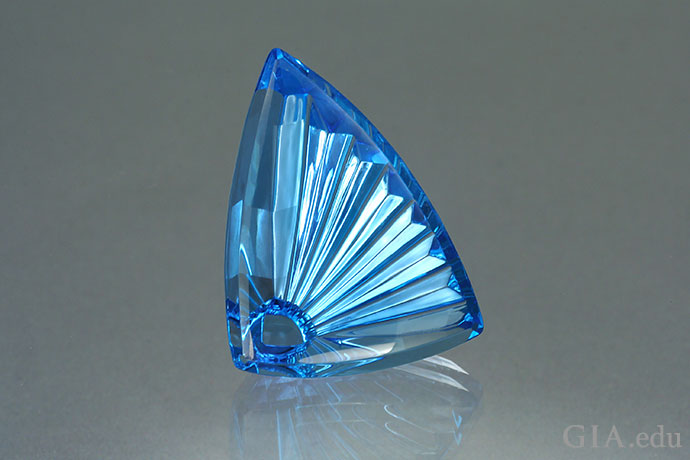
The artistic carving of this 38.56 ct blue topaz intensifies the color. Photo: Lydia Dyer. Courtesy: John Dyer & Co.
November birthstone: Where topaz comes from
Minas Gerais, a state in Brazil, is one of the most important sources for high-quality topaz. Yellow to orange, red, pink, violet and blends of red with orange or purple are some of the colors unearthed here. The nearby town of Ouro Preto is a fitting companion. In this UNESCO world heritage site, majestic colonial churches checker the skyline and quaint cobblestone streets crisscross the city.

Topaz mined from the Ouro Preto region of Minas Gerais, Brazil comes in a lovely range of hues, as displayed in this necklace set with a 24.13 ct fancy-cut topaz and the accompanying 44.11, 71.21 and 66.66 ct loose stones. Photo: GIA and Harold & Erica Van Pelt. Courtesy: Amsterdam Sauer Co.
Northwestern Pakistan is known for producing pink topaz. Ghundao Hill, close to the small town of Katlang, has been mined since 1972. The most sought-after shade of pink topaz from Katlang has a tinge of violet, which some in the gem trade call cyclamen pink. But even at Ghundao Hill, only rarely is fine pink topaz found.
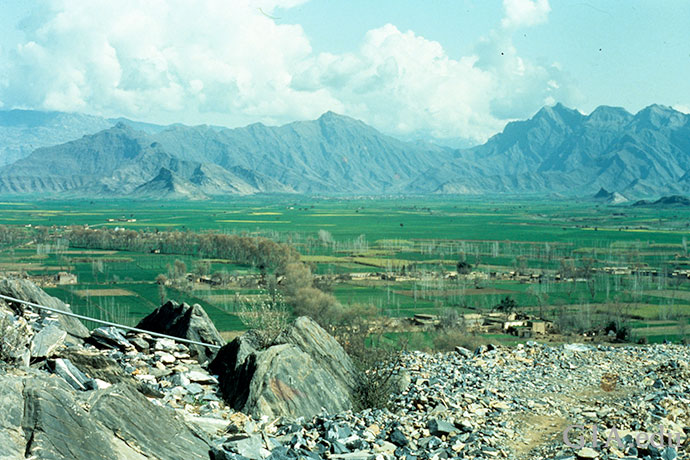
Ghundao Hill’s setting is quite picturesque: A valley carpeted in green starts at the base. The towering Hindu Kush Mountains rise in the distance. Photo: Dr. Edward J. Gübelin/GIA
Other topaz sources include Namibia, on the western coast of southern Africa, and the gem-rich island of Madagascar. Today, some topaz is also found in the historic Russian localities and elsewhere including, Africa, China, India, Myanmar, Sri Lanka and Vietnam, as well as the United States and Mexico.
November birthstone: Qualities to look for in topaz
Color: Blue topaz and colorless topaz are widely available and very affordable. Most of the blue topaz on the market today has been color treated, as described in the next section. Red and pink topaz varieties are rare, highly cherished and will carry a significantly higher price tag per carat. Imperial topaz is also highly prized.

A royal enchantment: This 11.11 ct Imperial topaz is accented with 0.29 carats of rubies and 0.75 carats of diamonds, all set in rose gold. Courtesy: Omi Privé
Clarity: Faceted blue topaz is almost always free of eye-visible inclusions. Topaz in colors that are not as plentiful may be included. Depending on the rarity of the color, inclusions may not have a significant effect on value.
Cut: Topaz is cut in a wide variety of shapes and styles, including emerald, cushion, oval, pear, round, triangular, marquise and fantasy cuts.
Carat weight: If the color of the topaz is considered rare, the per-carat price may rise dramatically as size increases.

This 1,002 ct fantasy cut topaz is a work of art. Photo: Orasa Weldon/GIA
November birthstone: Topaz treatments, care & cleaning
To clean this November birthstone, do not use steam cleaning or ultrasonic cleaners to clean topaz: Warm, soapy water works best.
Topaz is often treated. Since naturally colored blue topaz is extremely rare, colorless topaz is often processed with irradiation followed, in some cases, by heating to turn it various shades of blue. The three irradiation techniques used are exposure to gamma rays in a cobalt irradiator, bombardment with electrons in an accelerator and bombardment with neutrons in a nuclear reactor. Gems that are treated in an accelerator or nuclear reactor may become radioactive, but the U.S. National Regulatory Commission (NRC) does not allow release of such stones into the trade until radioactivity levels fall below certain limits. The NRC advises that “any dose from these gems would be extremely small” and would continue to go down. Dealers use terms like “London blue,” “Swiss blue,” “super blue” and “maxi blue” to describe darker blues, and “sky blue” for paler hues. In general, darker blues cost slightly more than lighter hues, but both are typically affordable.
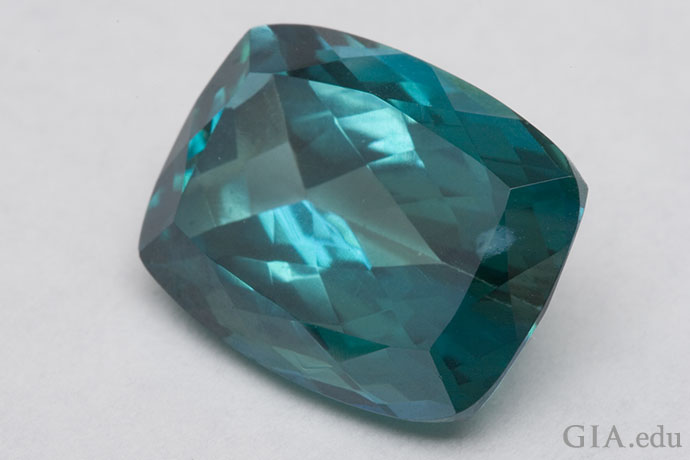
This blue topaz has undergone irradiation to achieve this color result often referred to as “Mystic Topaz” or “Caribbean Topaz” by the trade. Photo: Valerie Power/GIA
Also common, is the heating of yellow to reddish brown topaz to create pink gems. Both irradiation and heat treatment are permanent under normal conditions of wear and care. For the most part, they are undetectable.
High heat or sudden temperature changes can cause internal breaks in topaz. The gem’s color is generally stable to light, but prolonged exposure to heat or sunlight might cause fading in yellow-to-brown, reddish brown or dark brown gems. Topaz may be affected slightly by some chemicals.
In addition to irradiation and heat treatment, colorless topaz is sometimes coated with a thin metallic film to change the color or produce a fanciful iridescent effect. The coating can resist daily wear and tear, but abrasive cleaners or buffing wheels will remove it. Only a mild soap solution should be used to clean a topaz treated in this manner.
November birthstone: Gemological properties of citrine
Citrine is the transparent pale yellow to brownish orange variety of quartz. The finest citrine color is a saturated yellow to reddish orange free of brownish tints. Its color comes from traces of iron. However, this November birthstone is actually rare in nature: Most citrine on the market is the result of heat treating amethyst.
Citrine’s attractive color, plus the durability and affordability it shares with most other quartzes, makes it the top-selling yellow-to-orange gem. Gemologists love this November birthstone because it has a modest price tag, and the price per carat does not rise dramatically for larger sizes.

The Jolie Citrine Necklace, once owned by American actress Angelina Jolie and now part of the National Gem Collection at the Smithsonian Institution, features 64 graduated bezel-set cushion cut citrines, highlighted by a 177.11 ct pear shaped citrine drop. Courtesy: RP Studio
November birthstone: Citrine history & lore
This November birthstone is a variety of quartz, which has been used in jewelry for thousands of years. The ancient Greeks carved rock crystal ornaments that glistened like permafrost. Roman pontiffs wore rings set with massive purple amethysts and citrine has been reported in Roman jewelry. It was particularly popular in colorful Scottish jewelry from the Victorian era. Citrine, believed to derive from the French word for lemon (citron), is given for the thirteenth wedding anniversary.

A fantasy cut unleashes the fire within this 43.49 ct citrine. Photo: Priscilla Dyer. Courtesy: John Dyer & Co.
November birthstone: Where citrine comes from
The top sources for natural citrine are Bolivia, Spain, Madagascar, Mexico and Uruguay. Amethyst that’s typically heat treated to a citrine color is mined mostly in Brazil.

These citrine and diamond butterfly earrings remind us of the beauty surrounding the Anahí mine in Bolivia. Photo: C. D. Mengason/GIA. Gift of Denoir
Deep in the world’s largest freshwater wetland lies Bolivia’s Anahí mine, an important source for natural, unheated citrine. Fields of wild flowers, brightly plumed birds, kaleidoscopes of butterflies, Howler monkeys and jaguars are some of the actors on this vast stage. The story of the mine is worthy of the setting. Discovered by a Spanish conquistador in the 1600s, it was given to him as dowry when he married Anahí, a princess from the Ayoreos tribe of Paraguay. The mine was lost for three centuries, until it was rediscovered in the 1960s.

Cradled between the two mountains lies the Anahí mine in Bolivia. Photo: Robert Weldon/GIA
The Anahí mine produces a unique combination of amethyst and citrine in the same crystal; when the two colors appear together in a fashioned gem, it is known as ametrine. The citrine produced at the Anahí mine typically ranges from orange-yellow to brownish/greenish yellow.

The Anahí mine produces citrine, amethyst and ametrine gems in a broad range of hues. Photo: GIA & Tino Hammid
November birthstone: Qualities to look for in citrine
- Color: The finest citrine colors are saturated, with little to no brown component, and range from yellow to orange-yellow to reddish orange. Look for warm, sunny hues.
- Clarity: Citrine is usually “eye clean,” meaning it lacks eye-visible inclusions. Visible inclusions in a pale-colored gem greatly reduce the citrine’s value.
- Cut: Citrine is available in a wide variety of standard shapes and cutting styles. In addition, many high-end gem carvers have fashioned the warm yellow gem into unusual fantasy cuts for distinctive jewelry and objets d’art. Citrine rough with minor inclusions is often used to make beads or is used occasionally for cabochons or more conventional carvings.
- Carat weight: Citrine crystals occur in a wide range of sizes, and faceted stones up to 20 carats are readily available in jewelry.
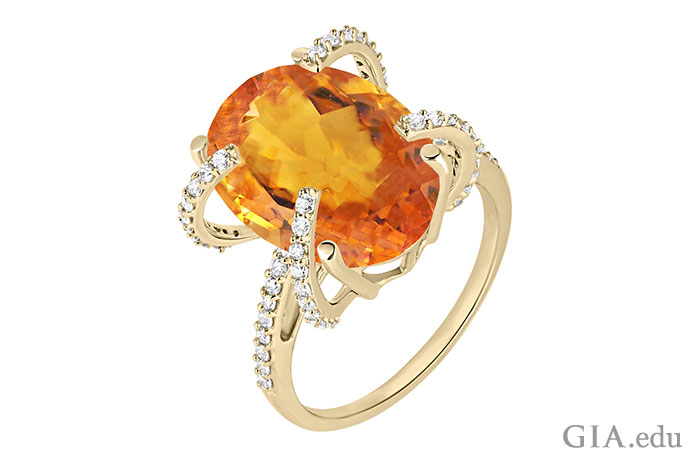
Like an ember, citrine glows in this ring. Courtesy: Arya Esha
November birthstone: Citrine treatments, care & cleaning
Citrine can be safely cleaned with warm, soapy water. While it is usually okay to clean citrine in an ultrasonic machine, steam cleaning is risky since citrine should not be subjected to heat.
As noted above, most of the citrine on the market is the result of heat treatment, which causes some amethyst to change color from an undesirable pale violet to an attractive yellow. In some cases, a darker starting material is used, as the amethyst’s original hue can determine the richness of the resulting citrine’s yellow color.

Spring Bouquet, a pendant made for Rio Tinto’s “Diamonds with a Story” marketing campaign, glows with a 15 ct citrine encircled by 0.30 carats of diamonds. Courtesy: Matthew Campbell Laurenza
Love topaz? Craving citrine? You’ll find our Topaz Buying Guide and Citrine Buying Guide to be extremely helpful.
